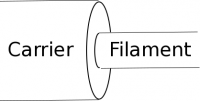Project 5
Project 5A: Lightbulbs'R'Us and JPL
Continuing T.R.O.J.A.N forces collaboration with the Jet Propulsion Laboratory (JPL) Division of NASA, you and your team are working with a group of electrical engineers at Lightbulbs'R'Us. Given the problems that Lieutenant Pete “Maverick” Mitchell has been having with the warning lights, the Jet Propulsion Laboratory (JPL) Division of NASA has placed a large order for a new set of warning lights for their power delivery system. They have told you that a current of 2.5 A down the carrier wire should turn on the warning light. Unfortunately, due to JPL's time schedule, you do not have time to order LED bulbs and must construct the lightbulbs the old fashion way using a filament (very thin piece of wire, diameter = 0.1 mm) connected to the carrier wire (normal electrical wire, diameter = 1.63 mm). You happen to have the following metals in the warehouse, with known electron densities and electron mobilities. Which metals do you want to use for the carrier wire and for the filament? JPL would also be interested in knowing what kind of battery would be needed to power the lightbulbs and the electric field from the surface charges on your wires to make sure it doesn't interfere with their other equipment.
Learning Goals:
- Use the ideas of energy conservation and charge conservation to analyze a circuit.
- Compare quantities like current, electric field, potential difference, and power for the thin and thick parts of the wire.
- Explain what is resistivity/conductivity and how it relates to resistance.
- Explain how current, voltage, and resistance are related and how you used these ideas in your solution.
Project 5B: Design a Defib
The Artemis 13 has launched and T.R.O.J.A.N force is on board and currently hanging in lower Earth orbit. You and a team of scientists are testing the life support systems for extended space travel aboard the ship. During a training exercise, your android co-pilot Johnny 5 begins to malfunction, it is essential that Johnny 5 not lose all power as he has an important role in the mission. Andrea Baker, the team leader mentioned that in a training video she saw back in the 80's call “Short Circuit 2” a model like Johnny 5 was brought back to life using a defibrillator.
You run to the medical bay and grab the defibrillator and rush back to Johnny 5. When you go to charge the defibrillator, however, you notice that the instruments are not reporting a proper charge. In order to not risk the safety of Johnny 5 by shocking him with faulty equipment, you decide against pressing the button and shouting “clear.” You need to save Johnny 5. Using your knowledge of electromagnetism, you know you can create a makeshift piece of equipment to be able to stabilize Johnny 5.
You run to the stock room downstairs only to discover that it isn't fully supplied yet. The launch of the spacecraft was rushed in order to complete the mission. You do find sheets of aluminum, and various paper sheets, some electrical tape and wires, and a pair of all-purpose scissors.
The defibrillator must be able to deliver 360 J to Johnny 5 in order to stabilize him. Can you fix the instrument and save him?
The paper sheets are 0.5 m wide, 2 m in length, and vary in thickness (2 mm, 1 mm, 500 $\mu$m, 50 $\mu$m, 1 $\mu$m, 0.5 $\mu$m). The aluminum sheets are 0.80 m in length, 0.5 m wide, and 0.3 mm in thickness. The defibrillator has a high voltage power supply of 30 kV.
Learning Goals
- Explain how a capacitor charges and discharges
- Explain what changes about your capacitor when you have a dielectric
- Explain why you add a capacitor to a circuit and what would change about the circuit.
